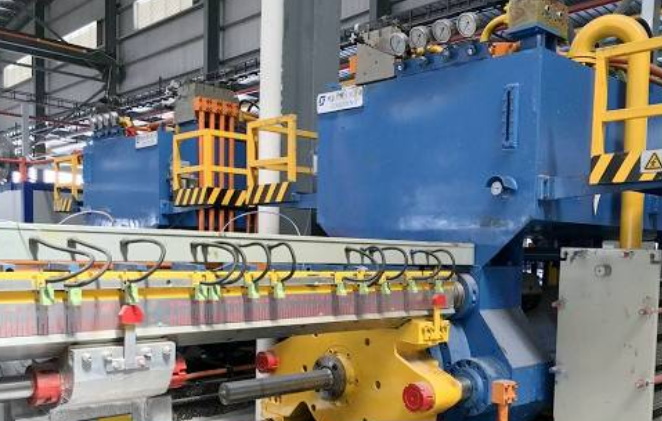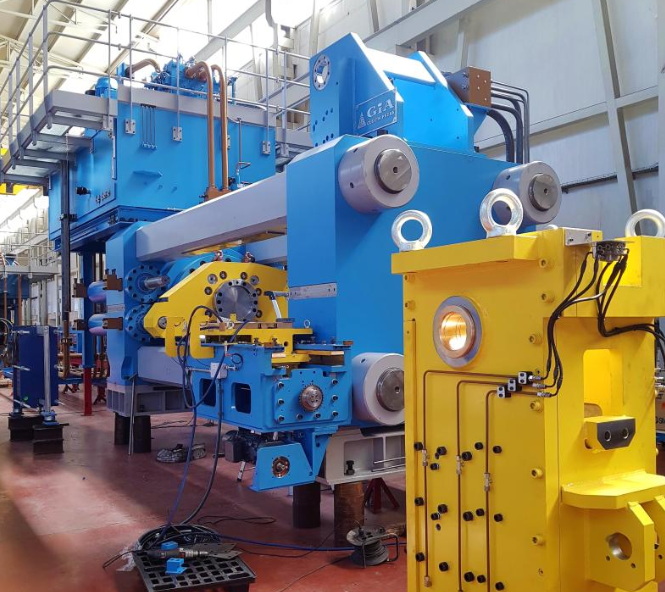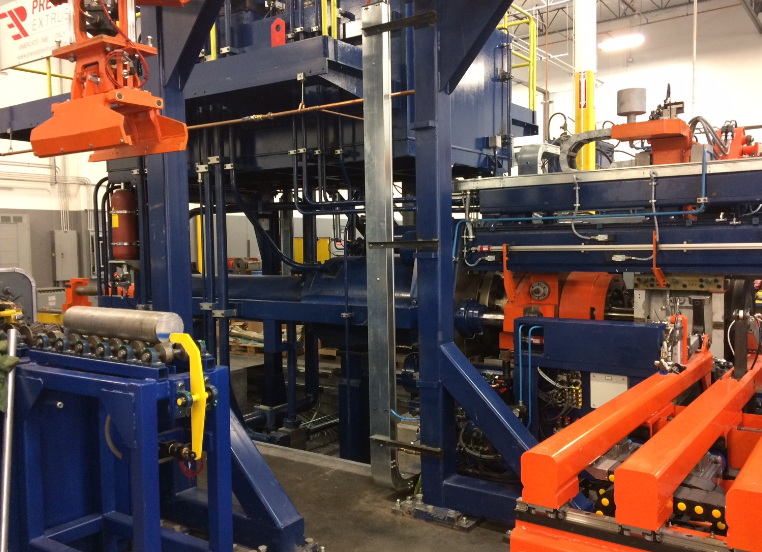Content Menu
● Understanding Aluminum Extrusion Press Components
● The Role of Shear Cylinders in Aluminum Extrusion
>> Key Functions of Shear Cylinders
● Impact of Shear Cylinders on Cycle Time
>> 1. Rapid Profile Cutting
>> 2. Efficient Butt Removal
>> 3. Precise Positioning
>> 4. Synchronization with Other Press Components
● Technological Advancements in Shear Cylinders
>> 1. Servo-Driven Systems
>> 2. Hydraulic System Optimization
>> 3. Integrated Control Systems
● Optimizing Shear Cylinder Performance for Reduced Cycle Times
>> 1. Regular Maintenance
>> 2. Precision Alignment
>> 3. Temperature Management
>> 4. Speed Optimization
>> 5. Advanced Control Systems
● The Future of Shear Cylinders in Aluminum Extrusion
>> 1. AI-Driven Optimization
>> 2. Advanced Materials
>> 3. Integration with Industry 4.0
>> 4. Energy Efficiency
● Conclusion
● FAQ
>> 1. What is the primary function of shear cylinders in aluminum extrusion presses?
>> 2. How do shear cylinders contribute to reducing cycle time in aluminum extrusion?
>> 3. What are some recent technological advancements in shear cylinder design for aluminum extrusion presses?
>> 4. How important is temperature management in relation to shear cylinder performance?
>> 5. What future developments can we expect in shear cylinder technology for aluminum extrusion presses?
● Citations:
Aluminum extrusion is a crucial manufacturing process in various industries, from construction to aerospace. One of the key components in this process is the shear cylinder, which plays a vital role in optimizing the cycle time and overall efficiency of aluminum extrusion presses. In this comprehensive article, we will explore the significance of shear cylinders in aluminum extrusion press operations and their impact on cycle time reduction.

Understanding Aluminum Extrusion Press Components
Before delving into the specific role of shear cylinders, it's essential to understand the basic components of an aluminum extrusion press. An aluminum extrusion machine typically consists of a front platen and back platen held together by four tie rods. The main components that facilitate the extrusion process include:
1. Main Cylinder: The chamber and cylinder into which hydraulic fluid is pumped to generate the desired ram pressure and movement.
2. Hydraulic Pressure System: Responsible for moving the ram forward at the required pressure.
3. Ram: A steel rod attached to the main cylinder with a dummy block on the end that enters the container and applies pressure to the billet.
4. Dummy Block: A component that separates the ram from the aluminum billet during extrusion.[4]
In addition to these core components, shear cylinders play a crucial role in the extrusion process, particularly in optimizing cycle time.
The Role of Shear Cylinders in Aluminum Extrusion
Shear cylinders are hydraulic components that are integral to the aluminum extrusion press cycle. Their primary function is to operate the shear mechanism, which is responsible for cutting the extruded profile at the end of each cycle. The shear cylinders work in conjunction with direct and indirect shears to cut the extruded part from the butt (the unextruded portion of the billet remaining in the container after the extrusion cycle is completed).[1]
Key Functions of Shear Cylinders
1. Profile Cutting: The most crucial function of shear cylinders is to power the shearing mechanism that cuts the extruded aluminum profile at the end of each extrusion cycle.
2. Butt Removal: Shear cylinders also assist in the butt removal process. A butt eject cylinder, which is part of the shear system, pushes the butt into a butt catcher.[1]
3. Positioning: Swivel cylinders, which are part of the shear system, move the butt catcher into and out of the press, ensuring proper positioning for butt removal.[1]
4. Cycle Time Optimization: By efficiently performing these functions, shear cylinders contribute significantly to reducing the overall cycle time of the extrusion process.
Impact of Shear Cylinders on Cycle Time
The efficiency of shear cylinders directly impacts the cycle time of aluminum extrusion presses. Here's how:
1. Rapid Profile Cutting
Modern aluminum extrusion presses are designed for high-speed operations. For instance, extrusion rams can advance at speeds of 4.7 inches per second and return at 4.5 inches per second. The main ram typically has an impressive 65-inch bore and 13.4-foot stroke.[1] To match these high-speed operations, shear cylinders must operate quickly and precisely to cut profiles without causing delays.
2. Efficient Butt Removal
The butt is the unextruded portion of the billet remaining in the container after the extrusion cycle is completed. Efficient removal of this butt is crucial for maintaining a smooth production flow. Shear cylinders, working in tandem with the butt eject cylinder and butt catcher, ensure that this process is completed swiftly, minimizing downtime between extrusion cycles.[1]
3. Precise Positioning
The accuracy and speed with which shear cylinders position the butt catcher and other components can significantly impact cycle time. Any delays or inaccuracies in positioning can lead to increased cycle times and potential issues in subsequent extrusion cycles.
4. Synchronization with Other Press Components
Shear cylinders must work in perfect synchronization with other press components, such as the main extrusion cylinders and hydraulic systems. Modern extrusion presses often use advanced control systems, including servo-controlled pumps, to ensure this synchronization. For example, the main pumps in some systems can have a design flow of 150 gallons per minute, with both closed-loop speed and pressure control.[1]

Technological Advancements in Shear Cylinders
Recent technological advancements have further enhanced the role of shear cylinders in reducing cycle times:
1. Servo-Driven Systems
Some modern extrusion presses now incorporate servo-driven systems for container and shear operations. These servo motors are often fixed on the machine base to avoid heat and vibration effects. This setup allows for more precise control and faster operation of the shear cylinders, contributing to reduced cycle times.[3]
2. Hydraulic System Optimization
Advanced hydraulic systems have been developed to decrease oil leakage and reduce the risk of fire around critical areas like the shear cylinders. These improvements not only enhance safety but also contribute to more efficient and reliable operation of the shear mechanisms.[3]
3. Integrated Control Systems
Modern extrusion presses often feature integrated control systems that optimize the operation of all components, including shear cylinders. These systems can adjust parameters in real-time, ensuring that shear operations are perfectly timed with the extrusion cycle.
Optimizing Shear Cylinder Performance for Reduced Cycle Times
To maximize the impact of shear cylinders on cycle time reduction, several strategies can be employed:
1. Regular Maintenance
Regular maintenance of shear cylinders is crucial for ensuring their optimal performance. This includes:
- Checking and replacing seals
- Monitoring hydraulic fluid levels and quality
- Inspecting for wear and tear on moving parts
2. Precision Alignment
Ensuring precise alignment of shear cylinders with other press components is essential for smooth operation and reduced cycle times. Regular calibration and alignment checks should be part of the maintenance routine.
3. Temperature Management
Temperature management is critical in aluminum extrusion. The temperature of the extrusion as it exits the press is typically monitored using instruments like the True Temperature Technology (3T) mounted on the press platen. For alloys like 6063, 6463, 6063A, and 6101, the target exit temperature is usually around 930°F (minimum), while for alloys like 6005A and 6061, it's about 950°F (minimum).[6] Proper temperature control ensures that the shear cylinders operate under optimal conditions, contributing to consistent cycle times.
4. Speed Optimization
The extrusion speed must be carefully controlled during the process. It significantly influences factors such as deformation heat effect, deformation uniformity, recrystallization, solid solution process, mechanical properties, and surface quality of the product. For instance, the extrusion speed (metal outflow speed) for 6063 alloy profiles can typically range from 20 to 100 meters per minute.[2] Shear cylinder operation must be synchronized with these speeds for optimal performance.
5. Advanced Control Systems
Implementing advanced control systems that can dynamically adjust shear cylinder operation based on real-time extrusion parameters can significantly reduce cycle times. These systems can:
- Predict optimal shearing moments
- Adjust shear speed and force based on profile characteristics
- Coordinate shear operations with other press functions
The Future of Shear Cylinders in Aluminum Extrusion
As the demand for faster and more efficient aluminum extrusion processes continues to grow, the role of shear cylinders is likely to evolve. Some potential future developments include:
1. AI-Driven Optimization
Artificial Intelligence could be employed to predict optimal shear timings and adjust cylinder operations in real-time, further reducing cycle times.
2. Advanced Materials
Development of new materials for shear blades and cylinder components could lead to longer-lasting, more efficient shear systems.
3. Integration with Industry 4.0
The concept of continuous flow, a core principle of lean methodology, aims to create a smooth, uninterrupted flow of materials and information throughout the production process. In the context of aluminum extrusion, this involves optimizing production layouts, minimizing batch sizes, and synchronizing operations to achieve a steady and consistent workflow. By eliminating bottlenecks and interruptions, manufacturers can enhance throughput, reduce cycle times, and improve overall efficiency.[8] Shear cylinders will likely become more integrated with Industry 4.0 principles, allowing for better data collection, predictive maintenance, and overall process optimization.
4. Energy Efficiency
Future developments may focus on making shear cylinder operations more energy-efficient, contributing to overall sustainability in aluminum extrusion processes.
Conclusion
Shear cylinders play a crucial role in optimizing the cycle time of aluminum extrusion presses. Their efficient operation in cutting profiles, removing butts, and coordinating with other press components is essential for maintaining high productivity in extrusion processes. As technology continues to advance, the role of shear cylinders in reducing cycle times is likely to become even more significant, contributing to faster, more efficient, and more sustainable aluminum extrusion operations.
By understanding and optimizing the function of shear cylinders, manufacturers can significantly improve their extrusion processes, leading to increased output, reduced costs, and improved product quality. As the industry continues to evolve, the ongoing development and refinement of shear cylinder technology will undoubtedly play a key role in shaping the future of aluminum extrusion.

FAQ
1. What is the primary function of shear cylinders in aluminum extrusion presses?
The primary function of shear cylinders in aluminum extrusion presses is to operate the shear mechanism, which is responsible for cutting the extruded profile at the end of each cycle. They work in conjunction with direct and indirect shears to cut the extruded part from the butt (the unextruded portion of the billet remaining in the container after the extrusion cycle is completed).[1]
2. How do shear cylinders contribute to reducing cycle time in aluminum extrusion?
Shear cylinders contribute to reducing cycle time by enabling rapid and precise cutting of extruded profiles, efficient butt removal, and accurate positioning of components like the butt catcher. Their synchronized operation with other press components ensures smooth transitions between extrusion cycles, minimizing downtime and optimizing overall process efficiency.
3. What are some recent technological advancements in shear cylinder design for aluminum extrusion presses?
Recent technological advancements in shear cylinder design include the integration of servo-driven systems, which allow for more precise control and faster operation. Additionally, advanced hydraulic systems have been developed to decrease oil leakage and reduce fire risks around critical areas like the shear cylinders. These improvements enhance both safety and operational efficiency.[3]
4. How important is temperature management in relation to shear cylinder performance?
Temperature management is critical in aluminum extrusion, including for shear cylinder performance. The temperature of the extrusion as it exits the press is typically monitored using instruments like the True Temperature Technology (3T). Proper temperature control ensures that the shear cylinders operate under optimal conditions, contributing to consistent cycle times and overall process efficiency.[6]
5. What future developments can we expect in shear cylinder technology for aluminum extrusion presses?
Future developments in shear cylinder technology may include AI-driven optimization for real-time adjustments, the use of advanced materials for longer-lasting components, greater integration with Industry 4.0 principles for improved data collection and predictive maintenance, and a focus on energy efficiency to contribute to overall sustainability in aluminum extrusion processes.
Citations:
[1] https://www.powermotiontech.com/applications/machine-tools/article/21884926/german-ww2-press-gets-a-new-life-in-the-us
[2] https://www.machine4aluminium.com/how-to-optimize-aluminum-extrusion-and-heat-treatment-processes/
[3] https://www.ubemachinery.com/news/documents/sshybridextrusion.pdf
[4] https://www.machine4aluminium.com/parts-of-aluminum-extrusion-machine-and-its-function/
[5] https://www.williamsonir.com/wp-content/uploads/2022/01/WilliamsonAluminumExtrusionproductsheet.pdf
[6] https://bonnellaluminum.com/tech-info-resources/aluminum-extrusion-process/
[7] https://www.daboosanat.com/wp-content/uploads/2018/02/0012-Extrusion-of-Aluminium-Alloys.pdf
[8] https://www.eztube.com/implementing-lean-methodology-in-aluminum-extrusion/
[9] https://www.nrel.gov/docs/fy22osti/80038.pdf






















